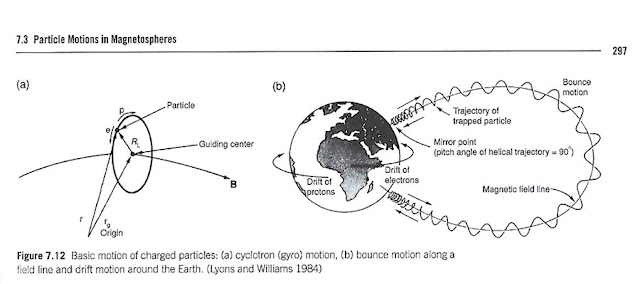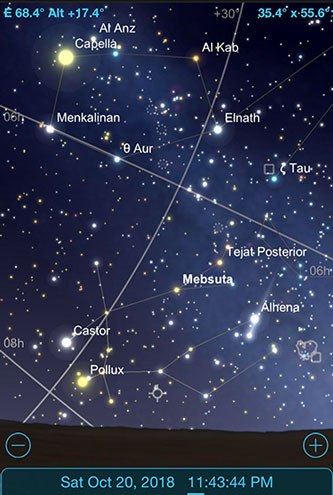Well we are back from the Mars 2020 NASA Workshop and I wanted to report on a neat explanation I found while skimming through the planetary sciences textbook about how ions from the solar wind become trapped in the Earth's magnetic field and build up into these large radiation fields that can be dangerous for spacecraft passing through.
Ok, so I found that Chapter 7 of the textbook, "Planetary Sciences" had an explanation for how ions can become trapped. The textbook does a great job of explaining this and many other topics. The writing is very clear and I can see why the authors won the AAS Chambliss Astronomical Writing Award for this book.
I always had a hard time understanding how ions could get trapped in the Earth's magnetic field because my background in electromagnetics assumed the case of uniform magnetic fields as outlined in part (a) of the figure below. In that case of constant magnetic field the ion will just circle around the field line continuously even though it might drift one way or the other along the field line. This concept didn't seem to support trapping because the ions would just travel along and then bump into the Earth and get absorbed. I was also working on the assumption that magnetic fields do not change the energy of moving particles and only change their direction. Well, if you decelerate a particle and start if going in the opposite direction this sure seems like a change in energy. So what else was going on?
The secret is outlined in part(b) of the figure which shows the trapped ion trajectory and how the drift motion along the length of the field line is brought to an end and actually reflected in the opposite direction in this "bounce" condition caused by the magnetic mirror. Because the field intensity is not constant and as a particle starts to approach the Earth, the vector forces on the particle change and begin to decelerate the drift velocity and actually cause the particle to reverse direction.
 |
| The Earth's non-uniform magnetic field can create trapped ions (Source: Pater & Lissauer, "Planetary Sciences") |
So the textbook explained how the Earth's magnetic field density is not constant and the field strength increases as you approach the magnetic poles. It is this change in field intensity that causes this magnetic mirror effect, which causes the trapped ions to be decelerated as they approach the poles and come to a stop and then reverse direction and follow the field lines back up in the other direction where another magnetic mirror effect causes the cycle to begin all over again. Of course, we know that some of the incoming particles are not deflected by the mirror and arrive and strike the Earth's upper atmosphere creating aurora and other effects. A neat description of the effect is posted below and other details are available at the website: http://www.phy6.org/Education/wtrap2.html
 |
| Magnetic mirror effect traps ionized particles in the Earth's magnetic field (Source: www.phy6.org) |
We know that the source of these ions is the solar wind which is made up of protons and electrons. I guess we can also suspect that many of the particles are not trapped but are deflected from the Earth. This is a good thing for us because otherwise we would be subject to being bombarded by the solar wind ourselves. We can also guess that many of the ions that follow the magnetic field lines down toward the Earth are not subject to enough of a magnetic mirror, due to their location further away from the Earth's magnetic poles, that the magnetic mirror effect is not strong enough to stop the forward motion and the ions slam into the upper atmosphere and cause auroras.
Ok, that is enough astrophysics for now and for all of you eclipse chasers, we can change topics, and say it is not too early to start planning for the 2019 total eclipse. We will be in Chile for the eclipse, but the same as the last total eclipse in 2017, we are still interested in identifying what the background stars will be at the 2019 eclipse. This is just part of the same imaging done for the 2017 eclipse where we could pretend that we would be able to compare the star positions, with and without the gravitational influence of the sun, and demonstrate the bending of light. Well, of course, we don't have real capability of doing real science with our little imaging camera, but it was fun pretending.
The following Sky Safari Pro screenshot shows the approximate location of the moon and sun as viewed from Orange County at about the time of the total eclipse on July 2, 2019. You can see they get to about 1/2 degree apart here at that time, but the background stars should be in the same approximate position here or there.
 |
| The 2019 total eclipse background star visible today, here in Orange County (Source: Palmia Observatory) |
You can notice that the star Mebsuta is pretty close to the eclipse location. The following Sky Safari Pro screenshot shows the background stars, around Mebsuta, for this current time of year. The background stars are rising and get above the horizon and should be more easily visible around 11:00 PM.
 |
| The 2019 total eclipse background star visible today, here in Orange County (Source: Palmia Observatory) |
Ok, so when I went out to take a photo of the background stars, which should be visible during the 2019 total solar eclipse, it turned out that the sky was just too cloudy. Hmmm, again, clouded out by the weather. Anyway, in the morning, when Astronomer Assistants Danny and Ruby, asked to go outside for their morning tour of the observatory grounds, the clouds had gone away, but the background stars were now so high overhead that I couldn't bend my neck or tripod far enough to take the photo. Ok, ok, next time! It also turns out that about a month from now, the eclipse background stars will be more easily visible here in OC at a more reasonable hour, like about 8-9 o'clock. So, let's plan to take the background star photo about a month from now.
By the way, since we were mentioning the Astronomer Assistants, I should comment about how they responded to our newest addition to the observatory, Neato, the Observatory Cleaning Robot. Here we see Neato going about his business, while the Astronomer Assistants observe in mostly quiet curious observation. They barked quite a lot initially, but seem to now recognize that Neato poses no danger and is not interested in playing with them.
 |
| Curious Astronomer Assistants, Ruby and Danny, follow Neato as he cleans the observatory (Source: Palmia Observatory) |
Until next time,
Resident Astronomer George
If you are interested in things astronomical or in astrophysics and cosmology
Check out this blog at www.palmiaobservatory.com

No comments:
Post a Comment